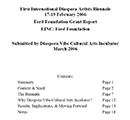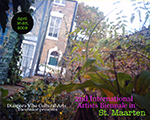Diaspora Vibe Gallery: Artist Biennale 2007, St. Maarten
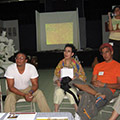
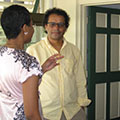
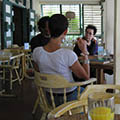
The International Diaspora Artists Biennale (IDAB) was conceived of by Rosie Gordon-Wallace, the curator of Miami-based Diaspora Vibe Gallery and director of the non-profit organization Diaspora Vibe Cultural Arts Incubator (DVCAI). The Biennale is part of a series of international cultural exchanges DVCAI arranges that have taken place throught the Caribbean and in France and Miami. DVCAI partners with local arts organization to present the Biennales, which are funded by Miami Dade Department of Cultural Affairs. The first IDAB was in Nassau, Bahamas in 2006, and the local partner was Popup Studios. The second Biennale was recently held in Philipsburg, St. Maarten with the Philipsburg Community and Cultural Center. In St. MAarten, over seven days, artists from St. Maarten, St. Martin, Jamaica, Aruba, and Trinidad, as well as those who trace their origins to the Dominican Republic, Cuba, China, and Africa came together in workshops and chat sessions to discuss their lives as artists.
The Biennale's goal is to facilitate creative, intellectual, and collegial exchange among artists who live in and outside of the Caribbean; to enable artists to see each others' work and hear each others' thoughts; and to provide them with professional development. Most of the artists who participate are of Caribbean descent, as are most of the artists represented by Diaspora Vibe Gallery.
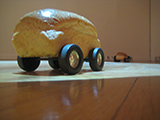
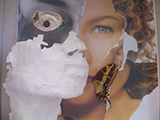
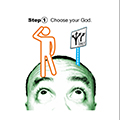
While IDAB states no specific outcomes other than the exchange itself, the hope is that targeted conversations will elucidate what it means to be an artist today generally, and specifically what it means to be a Caribbean artists working in the region or its diaspora.An additional hope is that formal and informal exposure to new people and places will generate new creative directions for individual artists and new friendships and collaborations among artists, Finally, because these exchanges rotate among different Caribbean countries, another implicit goal is for participants to learn more about the region.
In addition to presenting artwork and providing professional workshops, the Biennale was also meant to create a sense of community among the artists. Rosie […] kept the schedule flexible to allow for unexpected opportunities. […] the Biennale is held in the Caribbean partly “to escape the restrictive mentality” towards art and life often found in North America and Europe. Her Caribbean flexibility led to an entire day of studio visits, with carloads of artists traveling around the Dutch and French sides of St. Maarten/St. Martin to see where and how local artists live and work.
For many, these trips were the highlight of the Biennale. During the visits real exchange took place between the artists discussed everything from brush strokes to selling in the galleries, to storing paintings in a small studio space. The artists traveled to Ruby Blute’s welcoming gallery space inside her home – where everyone got a taste of homemade guavaberry rum – and to Lucy Trifan’s tiny studio where she keeps thousands of paintings in very careful order. Seeing where artists work deepened everyone’s understanding of their art is created. Though it was intended to link foreign and local artists, the Biennale also connected a number of St. Maarten artists who had never met!
The next Biennale will take place in another Caribbean country, though it may return to Philipsburg in the future. But its energy lingers on, as local artists promise to continue creating an artistic community, in addition to their individual art and careers.
Text adapted from Dr. Rosamund S. King's "From There to Here & Back: Implications of the International Diaspora Artists Biennale" (January 2008)
